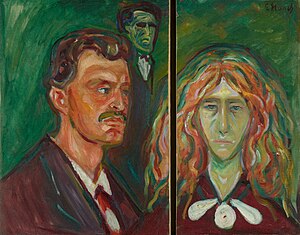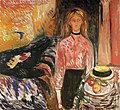Self-portrait with Tulla Larsen

|
| Self-portrait with Tulla Larsen |
|---|
| Edvard Munch , 1905 |
| Oil on canvas |
| 64/62 × 45.5 / 33 cm |
| Munch Museum Oslo |
Self-portrait with Tulla Larsen is an oil painting by the Norwegian painter Edvard Munch from 1905. The painting is a portrait of the artist himself and his lover Tulla Larsen. After the end of their relationship, Munch divided the picture into two parts, which in turn were given their own titles: Self-portrait against a green background (Norwegian: Selvportrett mot grønn bakgrunn ) and Caricature portrait of Tulla Larsen (Norwegian: Karikert portrett av Tulla Larsen ).
Image analysis and history
According to Giulia Bartram, a curator at the British Museum , the double portrait of Edvard Munch and his then partner Tulla Larsen is not one of the painter's best-known works. It was made at the height of their difficult relationship and shows a painter whose face has turned red and his annoyed-looking companion. After breaking up with Larsen in 1902, Munch saw the picture in two. Both parts remained in the family's possession and, like the entire estate of the painter, went to the Munch Museum in Oslo .
The ghostly facial expression of Tulla Larsen in the picture, her fixed, fixed gaze of green eyes and her blood-red snake hair are strikingly reminiscent of Elizabeth Lowry's lithography The Sin (Woman with Red Hair and Green Eyes) from 1902, in which the curly hair becomes one female siren parts like a curtain to expose her alluring breasts. Even in a man's head in woman's hair , it is the - again red - long hair of a woman that wraps itself around a man like a net, who becomes a captive, helplessly gasping victim. Larsen's successor Eva Mudocci held Munch in a similar pose in Salomé . The picture is named after the play of the same name by Oscar Wilde , in which a woman has the head of the man who rejects her chopped off. For more information on the symbolism of women's hair in Munch's work, see the section on women's hair as a symbol for the vampire image .
Sin (Woman with Red Hair and Green Eyes) (1902). Lithograph, 69.5 × 40 cm, Metropolitan Museum of Art , New York
Man's Head in Woman's Hair (1896). Woodcut, 54.6 × 38.1 cm, Sterling and Francine Clark Art Institute , Williamstown
Salomé (1903). Woodcut, 40.5 × 30.5 cm, Thielska galleriet , Stockholm
In 2019, in an exhibition at the British Museum in London, the two parts Self-Portrait Against a Green Background and Caricature Portrait by Tulla Larsen were shown for the first time in more than a century as a joint image, as they were originally conceived. In Gerd Woll's catalog raisonné from 2008, the two partial images are listed with the numbers 645 and 646, see also the list of paintings by Edvard Munch .
background
In 1898 Munch met Mathilde, known as "Tulla", Larsen, the six years younger daughter of a wealthy Norwegian wine merchant. In the following years the artist spent some of his summer stays in Norway at Larsen's side and also took her on trips abroad. The relationship was problematic, however, Matthias Arnold speaks of a love-hate relationship: Munch, who already had a difficult relationship with women, felt erotically attracted to the young, possessive woman, but at the same time oppressed and robbed of his freedom. Tulla Larsen was often referred to as Munch's fiancée, wedding plans were made, even if Munch always claimed in retrospect that only Larsen had spoken of an engagement and that he had never had any plans to marry. The relationship reached its dramatic climax and end in 1902 when, in an unsettled argument, possibly after a staged suicide attempt, a gunshot from a revolver (although it is not known whose hand it was in) and Munch came on top Lost the limb of his left middle finger.
Even if Munch only used his left hand to hold the palette while painting, the mutilated finger and constant pain reminded him of what was happening throughout his life and his fear of the danger of the feminine was confirmed. In a letter to his friend Jappe Nilssen in 1908/09, Munch wrote: “I understand that no one at home has seen or understood the vile actions of a rich social girl who no longer wants to live with her mother and who believes is that at the age of 30 the young girl days are over, are capable - and that his takers and pimps ... were willing to dig the grave I fell into - because they wrote the play that was supposed to destroy me ... It hit me right in the middle into the heart. "
There is an early x-ray image of his hand with the ball . Munch portrayed himself in a dramatic scene naked and with a bleeding hand on the operating table. In the years 1906/07 he dramatized the events in the pictures Mord , Die Mörderin and Marat's death ( identifying himself with Jean Paul Marat ) even further into a murder.
On the operating table (1902/03), oil on canvas, 109 × 149 cm, Munch Museum Oslo
Murder (1906), oil on canvas, 69.5 × 100 cm, Munch Museum Oslo
The Murderess (1906), oil on canvas, 110 × 120 cm, Munch Museum Oslo
Marat's Death I (1907), oil on canvas, 150.5 × 199.5 cm, Munch Museum Oslo
Marat's Death II (1907), oil on canvas, 153 × 149 cm, Munch Museum Oslo
The Murderess (1907), oil on canvas, 89 × 63 cm, Munch Museum Oslo
Individual evidence
- ↑ The German titles are not established in the literature, but translations of English titles or Norwegian original titles
- ^ Vanessa Thorpe: Edvard Munch 'reunited' with fiancee for the British Museum show . In: The Observer of April 7, 2019.
- ↑ Elizabeth Lowry: Trying to find an essence. 'Sickness, the snare of sexuality, and loneliness': the idées fixes of Edvard Munch. . In: The Times Literary Supplement, May 24, 2019.
- ↑ Carmen Sylvia Weber (ed.): Edvard Munch. Vampire. Readings on Edvard Munch's Vampire, a key image of the early modern age . Catalog for the Edvard Munch exhibition . Vampire , January 25, 2003 - January 6, 2004, Kunsthalle Würth , Schwäbisch Hall. Swiridoff, Künzelsau 2003, ISBN 3-934350-99-2 , p. 23.
- ^ Meilan Solly: British Museum Reunites Portrait That Edvard Munch Sawed in Half to Avenge His Fiancée . In: Smithsonian Magazine April 10, 2019.
- ^ Matthias Arnold: Edvard Munch. Rowohlt, Reinbek 1986. ISBN 3-499-50351-4 , pp. 88-89.
- ↑ Reinhold Heller: Edvard Munch. Life and work. Prestel, Munich 1993. ISBN 3-7913-1301-0 , p. 102.
- ^ Matthias Arnold: Edvard Munch. Rowohlt, Reinbek 1986. ISBN 3-499-50351-4 , pp. 90-91.
- ^ Matthias Arnold: Edvard Munch. Rowohlt, Reinbek 1986. ISBN 3-499-50351-4 , pp. 91-92.
- ^ Sue Prideaux: The soul laid bare. Edvard Munch at Tate Modern I . On the Tate Gallery website , August 27, 2012.
- ^ Anna Sidelnikova: Love story in paintings: Edvard Munch and Tulla Larsen . In arthive.com.
Web links
- Selvportrett mot grønn bakgrunn in the Munch Museum Oslo (Woll M 645)
- Karikert portrett av Tulla Larsen in the Munch Museum Oslo (Woll M 646)
- Vanessa Thorpe: Edvard Munch 'reunited' with fiancee for British Museum show . In: The Observer of April 7, 2019.








